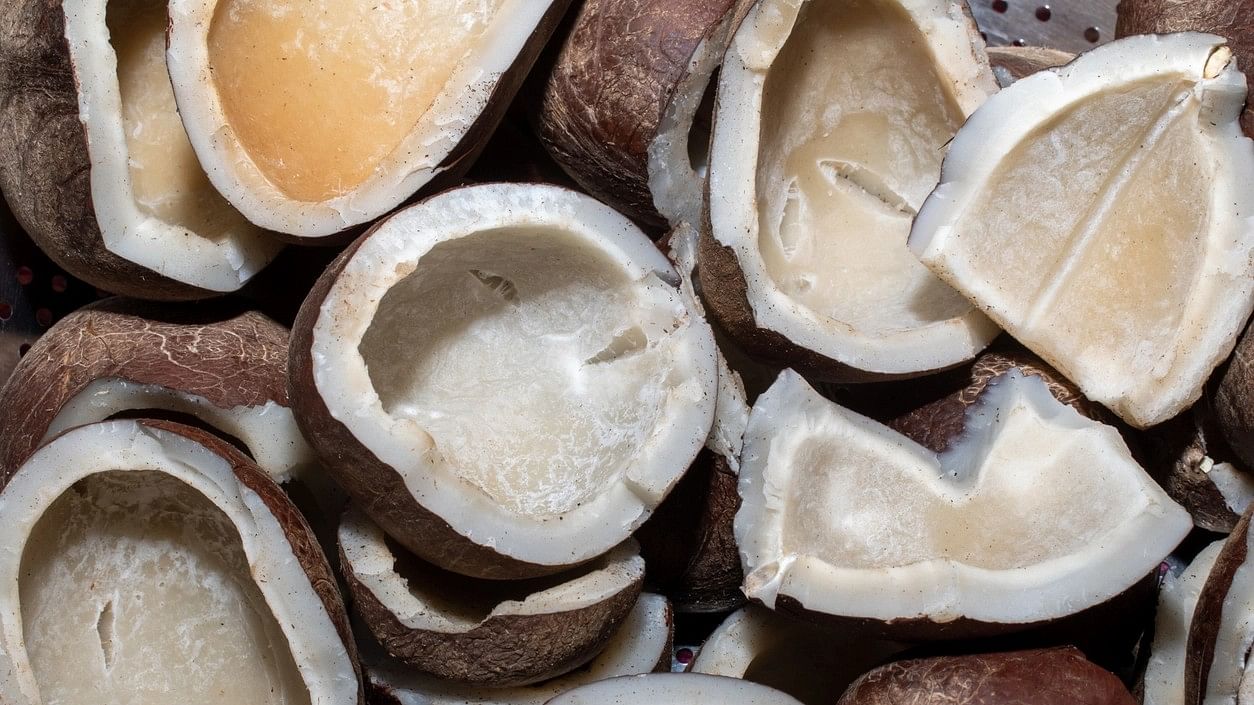
Representative image.
Credit: iStock Photo
Prices of copra have taken a nosedive in the state, falling by about 50% in the past four to five months.
This drastic reduction, farmers and experts say, is the result of a lack of government intervention to rein in the increased import of palm oil at subsidised rates and the government’s failure to procure copra to stabilise prices.
Karnataka is the third largest producer of coconuts in the country after Kerala and Tamil Nadu.
Growing districts
India produces 34% of the world’s supply of coconuts. A majority of farmers in Tumakuru, Hassan and Mandya and a significant portion in Chitradurga, Mandya, Udupi and Dakshina Kannada districts are dependent on coconut cultivation for livelihood.
The non-stop import of palm oil has impacted coconut growers, say farmers and experts.
This has led to a decline in demand for traditional oilseeds like sunflower, safflower and groundnut, apart from copra.
In fact, a study over a 15-year period between 2005 and 2021 showed that the area under oilseeds had declined by 14.65 lakh hectares in the state.
Siddeshprasad, a coconut farmer in Tumakuru, explains the impact of the plunge in prices.
Big slump
“The price fell from Rs 14,000 per quintal a couple of months ago to Rs 7,700 now. The cost to produce a quintal of copra, including cultivation and transportation, comes to Rs 9,000. We are operating at a loss,” he says.
Siddeshprasad has cultivated coconut trees on 5 acres of land and the sale of copra constitutes his primary income.
A drop in prices of this magnitude has not occurred in the recent past, according to Ramesh, a coconut farmer from Tovinakere.
“If farmers have additional commitments, for instance a vehicle or education loan, how are they supposed to survive?” he says.
“In 2018, the price of copra was around Rs 14,000. This price was stagnant for several years after that, even though labour wages and cultivation costs had surged over the period,” he said.
Causes
Traders, Siddeshprasad says, have been citing a reduction in demand for copra in cooking.
Additionally, ball copra, the variety commonly grown in Karnataka, is not commonly used to produce coconut oil, according to Prakash Kammardi, professor and head of the department of agricultural economics at the University of Agricultural Sciences.
In fact, Karnataka accounts for 65% of the total production of ball copra in the country.
In the past, ball copra was thought to be a safer bet. However, when weather conditions vary, moisture could collect inside the shell of ball copra, affecting the yield.
There is a fall in demand for ball copra used in cooking food, according to traders. The fall in demand can be expected following the festival season, but this is not the only reason behind the reduction in prices of copra in the state.
Kammardi explains that to improve the conditions of coconut farmers and to provide price stabilisation, an intervention in procurement is necessary.
To start with, even though copra prices have fallen by 50%, procurements by the national-level farmers co-operative marketing organisation (NAFED) have stopped.
‘Govts failing growers’
Ramesh explains that in such crises, “moving fast to stabilise prices is the key. Both the state and central governments are failing us.”
Under the current process of procurement, the state government needs to prove a fall in prices in the markets at the district level. NAFED then approves procurement orders, with union government funding.
“The process is long and as a result, price stabilisation is not happening in time. The state government should have a say in flagging price drops and intervening,” he says.
Edible oil pricing
Anekatte Vishwanath of the Coconut Growers Association feels that the prices of copra are inextricably linked with edible oil pricing. “The import of palm oil has had a major effect on coconut growers,” he says.
In fact, India is the largest importer of palm oil in the world. Due to its wide availability and cheap rates, an official in the agriculture department explains, it has outcompeted coconut oil in even regions where the latter had a stronghold.
Regional import mandates through SAARC have also made palm oil import unavoidable.
India’s palm oil imports jumped 29.21% to 90.8 lakh tonne in the first 11 months of the ongoing 2022–23 oil year, compared with the year-earlier period, with RBD Palmolein shipments rising fast, posing a serious threat to domestic refiners, industry body Solvent Extractor’s Association of India said recently.
“Bad import policy combined with delayed procurement and price stabilisation has led to this scenario,” says Kammardi.
Diversification
To find a solution to high input costs, Vishwanath has been long advocating that farmers sell about 30-40% of their yield in the tender coconut stage.
“Another 30% can be sold as coconuts. Farmers should make sure that they are selling less than 30% of the yield in the form of copra,” says Vishwanath.
Value addition is also lacking, according to an official in the agriculture department.
“The government can think of introducing machines to deshell coconuts (already in the market). We should think of ways of reducing farmers’ input costs,” he says.